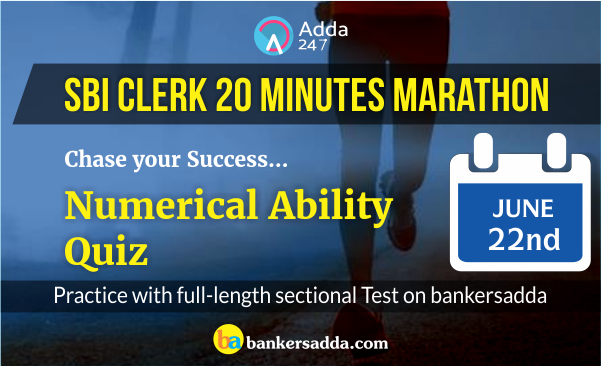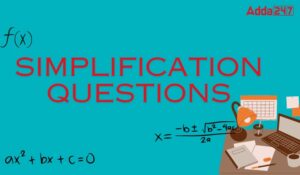Numerical Ability Sectional Test: 22nd June 2018
Following is the Quantitative Aptitude Full-Length quiz to help you practice with the best of latest pattern questions.
Q1. A sum of money invested at compound interest amount to Rs. 2400 in 3 years and in 4 years to Rs. 2,520. The interest rate per annum is:
Q2. What does Rs. 250 amounts to in 2 years with compound interest at the rate of 4% in the 1st year and 8% in the second year?
Q3. By selling an article for Rs. 240, a man incurs a loss of 10%. At what price should he sell it, so that he makes a profit of 20%?
Q4. The difference between the selling price and cost price of an article is Rs. 210. If the profit percent is 25, then the selling price of the article is:
Q5. A certain number of people were supposed to complete a work in 20 days. The work, however, took 28 days, since 8 people were absent throughout. How many people were supposed to be working originally?
Directions (6-10): Find out the approximate value which should replace the question mark (?) in the following questions. (You are not expected to find out the exact value)
Q8. 71.98% of 1200 + 35.06% of 270 =? % of 600
Q9. 88.05% of 450 =? % of 530
Q11. X and Y start from the same point and run around a circular stadium, whose circumference is 2800 m, at the rate of 250 m and 350 m per minute respectively in the opposite direction. They will meet each other in
Q12. A boy walks from his house to school at 2.5 kmph and arrives 12 minutes late. The next day he walks at 4 kmph and reaches the school 15 minutes earlier. What is the distance from his house to school?
Q13. Two trains start at the same time from points A and B towards each other and after crossing each other, they take 25 hours and 9 hours in reaching points B and A, respectively. Find the ratio of speeds of 1st train to that of 2nd train.
Q14. A train of length 250 metre, passes a platform of 350 metre length in 50 seconds. What time will this train take to pass a platform of 230 metre length?
Q15. In how many different ways the letters of word ‘COMBINATION’ can be arranged in order to keep the consonants always together?
Q16. A man’s downstream swimming rate is thrice of his upstream swimming rate. If he covers 12 km upstream in 2.5 hours, what distance he will cover in 5 hours downstream?
Q17. A cistern can be filled with water by pipe A in 5 hours and it can be emptied by a second pipe B in 4 hours. If both the pipes are opened when the cistern is full, the time in which it will be emptied is:
Q18. Two pipes can fill a tank in 20 and 24 minutes respectively and a waste pipe can empty 3 gallons per minute. All the three pipes working together can fill the tank in 15 minutes. The capacity of the tank is (in gallons):
Q19. The ratio of P’s and Q’s ages is 4: 5. If the difference between the present age of Q and the age of P 5 years hence is 3 years, then what is the total of present ages of P and Q?
Q20. Shivam is 4 years younger than Mayank while Divyanshi is 4 years younger than Samrat but one-fifth times as old as Shivam. If Samrat is eight years old, how many times as old is Mayank as Divyanshi?
Directions (21-25): In the following questions two equations numbered I and II are given. You have to solve both the equations and
Directions (26-30): The following table shows total no. of participants in all the five years together and their percentage distribution in each year respectively who get selected in five seasons of DID competition from various cities. Study the table carefully to answer the related questions

Q26. How many participants are selected in DID in 2007 from all the cities together?
Q27. No. of participants selected from Mumbai in the year 2006 is what percent more or less than that from Vadodara in the same year?
Q28. What is the average no. of participants in the year 2008 from all the cities together who get selected in DID? (approximately)
Q29. What is the ratio of participants selected from Lucknow in 2009 and 2010 together to that selected from Bhopal in the years 2009 and 2010 together?
Q30. If in 2005, the no. of selected participants from Delhi and Mumbai were 20% and 40% less than that in 2006 respectively then find the difference between selected participants of Delhi and Mumbai in the year 2005?
Directions (31-35): What will come in the place of the question mark (?) in the following number series?
Q31. 24, 12, 12, 18, 36, ?
Q32. 270, 225, 189, 162, 144, ?
Q33. 12, 13, 22, 47, 96, ?
Q34. 15, 16, 34, 105, 424, ?
Q35. 3, 5, 15, 45, 113, ?













 Simplification Questions For Bank Exams ...
Simplification Questions For Bank Exams ...
 Quantity Comparison Questions for Bank E...
Quantity Comparison Questions for Bank E...
 Mixture & Alligation Questions for B...
Mixture & Alligation Questions for B...




